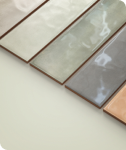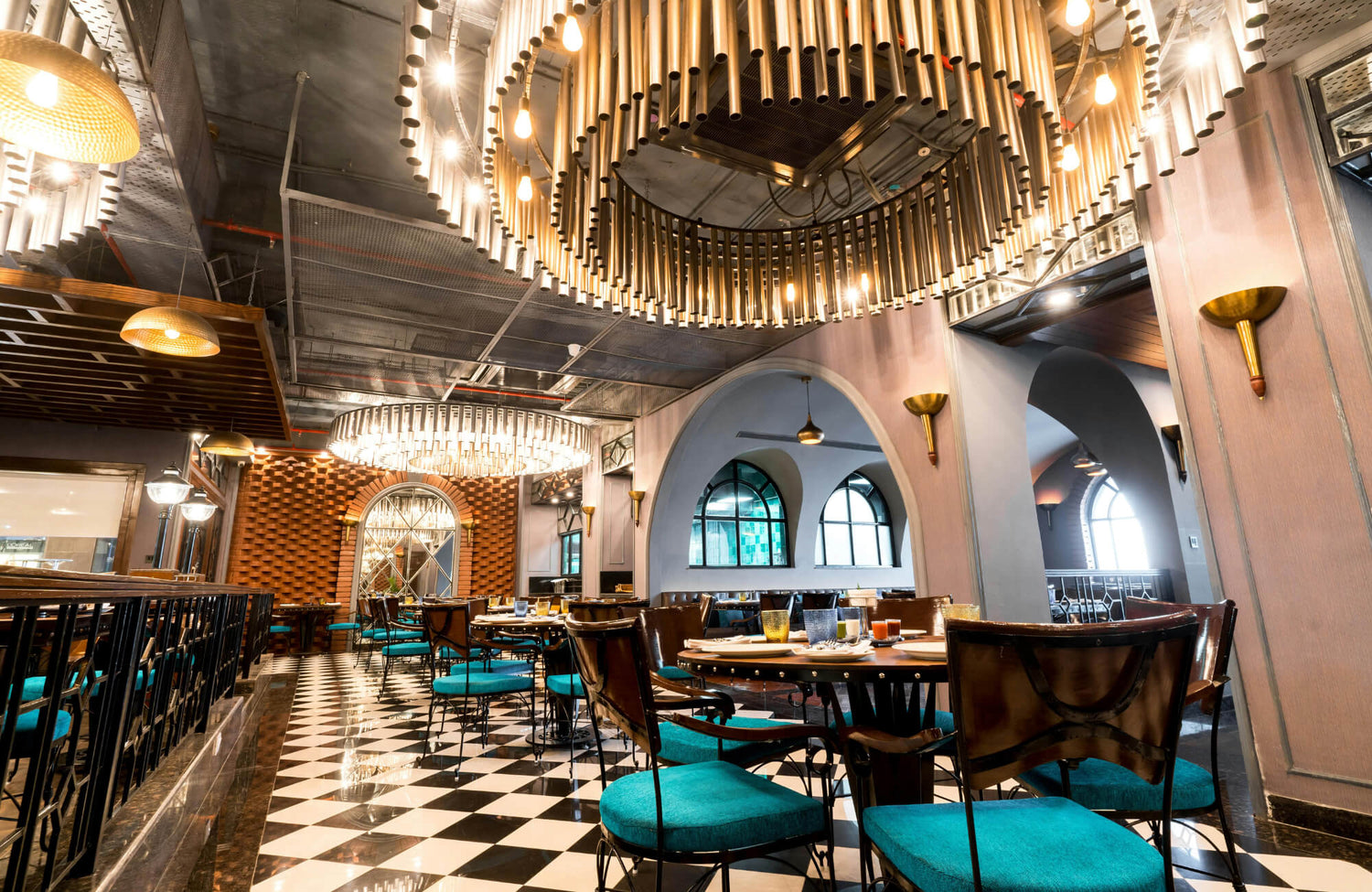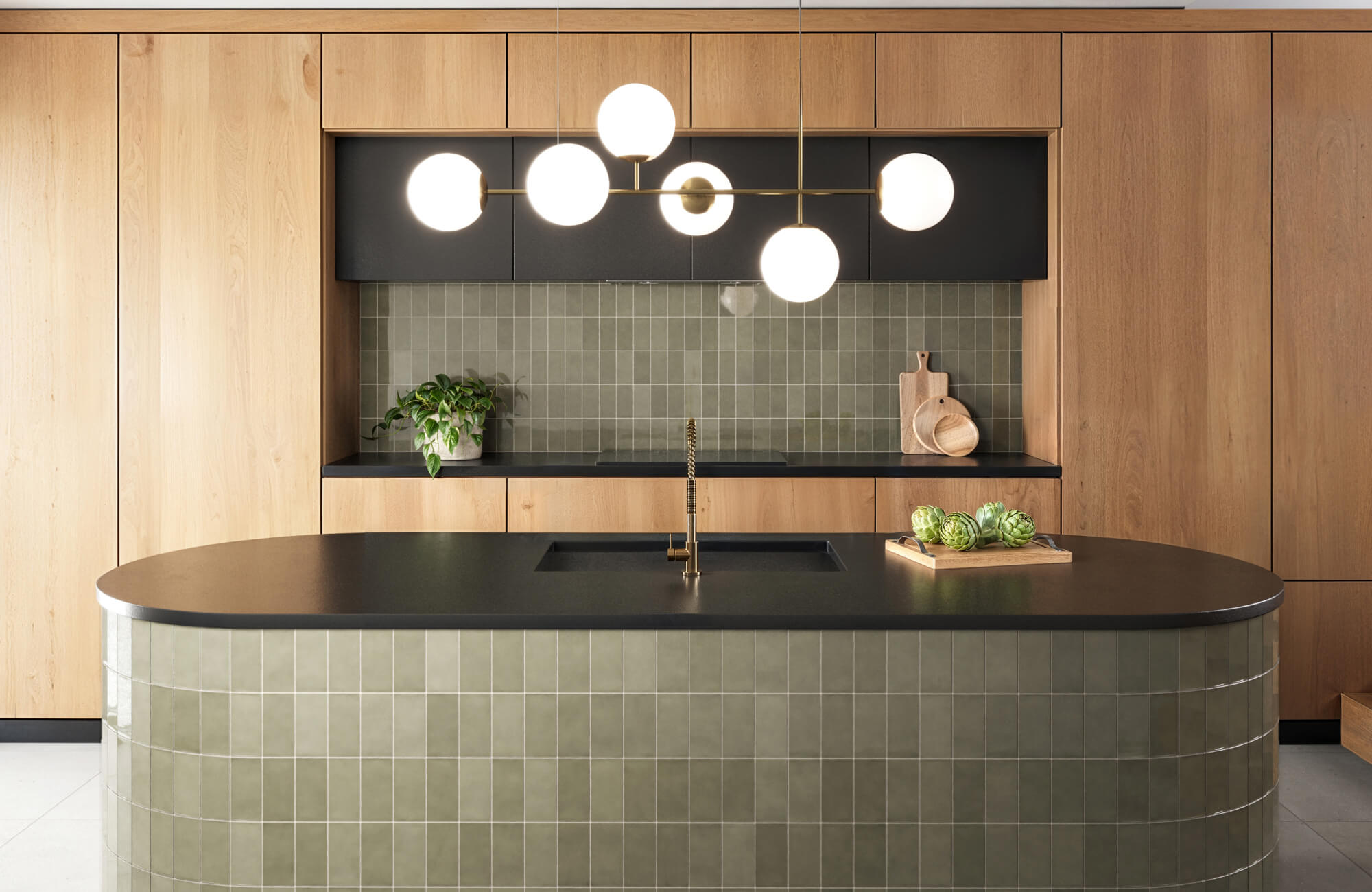Chequered tiles aren’t just a throwback to vintage elegance, they’re a dynamic design tool that brings structure, style, and substance to modern spaces. With their striking contrast and geometric rhythm, these tiles create bold focal points while subtly enhancing spatial flow and balance. More importantly, they’re built for real-world performance. In this blog, we’ll explore how chequered tiles combine everyday functionality with enduring visual impact, making them a smart, stylish choice for any space.
Elevating Aesthetics with Timeless Design
Chequered tiles have a unique way of transforming ordinary surfaces into standout design elements, blending bold visual impact with effortless style. From commanding attention in a room to adapting across diverse aesthetics, their design potential is as versatile as it is timeless.
Creating a Striking Focal Point
One of the most powerful attributes of chequered tiles lies in their ability to anchor a space through bold visual contrast. The alternating color pattern, commonly black and white, but increasingly available in modern combinations like grey/charcoal, beige/terracotta, or navy/cream, creates a high-impact surface that naturally draws the eye. When used on floors or accent walls, this inherent contrast acts as a dynamic focal point that breaks visual monotony and introduces a sense of rhythm and movement.
To enhance spatial definition, designers often use chequered patterns to guide sightlines or highlight architectural features. For instance, in elongated corridors or narrow entryways, a diagonal chequered layout can visually widen the space, enhancing dimensional perception. In open-plan layouts, a centered chequered zone can effectively delineate a seating area or dining section without the need for physical dividers. This visual clarity is further amplified when the tiles are manufactured with precision rectified edges, allowing for minimal grout lines and a seamless appearance that sharpens the overall geometry of the pattern.
Furthermore, the surface finish plays a crucial role in elevating the aesthetic. Glossy finishes introduce a reflective quality that interacts with ambient lighting, adding depth and sheen, while matte or textured finishes provide a more grounded, contemporary look. For a heightened sense of luxury, incorporating large-format chequered tiles or inlaid natural stones such as marble or travertine can elevate the space, creating a bespoke and enduring visual statement.
Embracing Versatility in Interior Design Styles
Just as chequered tiles can command attention, they also demonstrate remarkable versatility across a range of interior styles. From historical restorations to sleek, contemporary interiors. In traditional settings, such as Colonial, Victorian, or French country homes, the classic black-and-white chequered pattern evokes a sense of heritage and refinement. These tiles are often paired with ornate moldings, antique fixtures, and wainscoting to enhance period-authentic charm.
On the other hand, in contemporary and Scandinavian design schemes, chequered tiles are celebrated for their clean geometry and ability to introduce visual interest without disrupting a minimalist palette. Neutral tone-on-tone variations, such as beige and ivory, offer a more restrained interpretation of the pattern, aligning well with understated interiors. Meanwhile, in modernist or industrial contexts, bold high-contrast layouts can emphasize architectural elements like exposed brick, raw concrete, or metal framing, adding a layer of visual texture and sophistication.
Moreover, their adaptability is not limited to visual style, it extends to material selection and installation contexts as well. Porcelain chequered tiles, known for their high abrasion resistance and low porosity, are especially suited for busy areas like kitchens, mudrooms, and entryways. In contrast, encaustic cement tiles introduce artisanal richness and handmade character, ideal for eclectic or bohemian spaces. Importantly, chequered tiles can also be used to create cohesion between interior and exterior zones, making them an excellent option for spaces designed with indoor-outdoor flow in mind, such as patios, verandas, or garden-access living areas.

Enhancing Functionality and Practicality
While their visual appeal often takes the spotlight, chequered tiles also shine behind the scenes with features that make everyday living safer, easier, and more resilient. From standing up to heavy use to simplifying upkeep, their practical strengths are just as compelling as their design.
Ensuring Durability and Longevity
To begin with, chequered tiles, particularly those made from porcelain or vitrified ceramic, are engineered for exceptional wear resistance and structural integrity. Porcelain tiles, for instance, undergo high-temperature kiln firing, which results in a dense, non-porous composition that resists chipping, cracking, and surface abrasion. Consequently, they are ideal for heavily used zones such as foyers, commercial lobbies, kitchens, and hallways, where daily wear can quickly take its toll on less durable surfaces.
Moreover, in environments exposed to mechanical stress, such as industrial areas or exterior installations, chequered tiles with a PEI (Porcelain Enamel Institute) rating of IV or V offer optimal performance. These ratings signify suitability for heavy usage, ensuring that the tile maintains both structural integrity and visual appeal over time. Additionally, options with rectified edges and uniform sizing help reduce visible grout lines, which not only enhances aesthetics but also minimizes the risk of edge chipping, thereby extending the life of the installation.
Equally important, their long-term resilience is reinforced by resistance to UV fading, thermal shock, and chemical exposure, particularly when tiles are properly sealed or glazed. This makes them especially well-suited for transitional areas that bridge indoor and outdoor environments, such as sunrooms, patios, or covered walkways. For example, Edward Martin’s Palmer 12x12 Checkerboard Raw Porcelain Tile in White and Grey exemplifies this durability with its textured, non-slip surface and weather-resistant construction, making it an ideal choice for outdoor dining areas that demand both aesthetic charm and year-round performance, as featured in the photo above.
Simplifying Cleaning and Maintenance
In addition to their strength, chequered tiles are remarkably easy to maintain, a feature that makes them a favorite among homeowners and commercial property managers alike. Thanks to their high-density surface, particularly in porcelain and glazed ceramic formats, these tiles resist moisture absorption (often below 0.5% for porcelain), making them naturally stain-resistant and hygienic. As a result, spills, grime, and organic residue remain on the surface, allowing for effortless cleaning.
In residential applications such as kitchens and bathrooms, chequered tile floors can be kept spotless with basic pH-neutral cleaners and routine sweeping or damp mopping. For commercial environments, where sanitation standards are even more critical, these tiles are compatible with both manual and mechanical cleaning equipment, including steam cleaners and auto-scrubbers, offering flexibility in maintenance strategies.
Beyond ease of cleaning, the inherent pattern of chequered tiles contributes to functional cleanliness by visually masking light scuffs, dirt, or uneven wear between cleaning cycles. This helps maintain the appearance of a tidy environment, even in busy areas. To further enhance performance, epoxy-based grouts are recommended, as they outperform traditional cementitious grout in moisture resistance, stain repellency, and mold prevention. For best results and to preserve tile finishes over the long term, it's always advisable to follow the manufacturer’s care guidelines when selecting cleaning products or implementing maintenance routines.
Improving Safety with Slip Resistance
Equally vital to functionality is safety, especially in environments prone to moisture or heavy usage. Fortunately, chequered tiles can be manufactured with textured surfaces or anti-slip treatments that meet or exceed industry benchmarks for slip resistance. Measured using standards such as ASTM C1028 or ANSI A137.1, the coefficient of friction (COF) of these tiles can be specified to meet the demands of various settings; for instance, a COF of 0.60 or higher is typically recommended for general flooring applications.
In wet or transitional zones, such as bathrooms, laundry rooms, or entryways, installing chequered tiles with a matte or structured finish helps enhance traction, thereby reducing the risk of slips and falls. Outdoor installations benefit from frost-resistant and anti-slip formulations that retain grip even in damp or icy conditions. Moreover, in accessibility-focused environments like senior housing or healthcare facilities, choosing tiles that comply with ADA (Americans with Disabilities Act) guidelines ensures both safety and code compliance.
Beyond material and finish, the chequered pattern itself provides visual support for navigation and spatial awareness. The alternating colors can serve as visual cues, particularly helpful for individuals with limited vision, by clearly delineating paths, zones, or transitional thresholds. This thoughtful integration of aesthetic and tactile safety reinforces chequered tiles as a smart, universal flooring solution that supports both form and function across a wide range of applications.

Exploring Design Flexibility and Customization
Designing with chequered tiles opens up a world of creative possibilities, where even small tweaks can dramatically shift the mood and function of a space. Whether you're reimagining proportions, experimenting with color, or rethinking layout, these tiles invite you to make the design truly your own.
Playing with Scale and Proportion
To begin with, scale plays a crucial role in how chequered tile patterns influence spatial perception and overall ambiance. Standard chequered tiles typically range from 6"x6" to 24"x24", but selecting the right size is key to achieving the intended visual effect. For instance, large format tiles, such as 18"x18" or 24"x24", create a bold, expansive look that works particularly well in open-plan environments like hotel lobbies, spacious kitchens, and large foyers. These larger tiles also reduce grout joints, resulting in a cleaner and more continuous surface appearance.
Conversely, in more compact or detailed areas, smaller tile formats such as 4"x4" or mosaic configurations provide intricate visual detail without overwhelming the space. These are especially well-suited for powder rooms, stair risers, or backsplashes, where tight quarters benefit from visual refinement. Additionally, adjusting tile scale within different zones of a single space can create visual continuity while subtly distinguishing functional areas, a technique often used in luxury residential and boutique commercial settings.
Furthermore, proportion significantly impacts the harmony of a chequered layout. A traditional 1:1 color ratio delivers the classic checkerboard appearance, but exploring uneven proportions, such as 2:1 rectangular arrangements, can bring a fresh, avant-garde aesthetic. When paired with minimalist furnishings and architectural lighting, these proportional shifts elevate the floor from a backdrop to a focal design element.
Unleashing Creativity with Color Combinations
Equally important to tile size is the color palette, which offers another layer of customization. While black-and-white remains the quintessential chequered tile scheme, modern production techniques now allow for an expansive array of hues, finishes, and textures. This versatility enables more expressive and personalized designs, whether for private residences or branded commercial spaces.
From a psychological perspective, color selection has a direct impact on atmosphere. Warm tones like terracotta, taupe, and sand create an inviting, rustic charm, ideal for farmhouse kitchens or Mediterranean courtyards. In contrast, cool shades such as slate blue, sage green, or icy grey cultivate a sense of calm and sophistication, making them perfect for spa-inspired bathrooms or serene transitional areas. For bolder statements, high-contrast combinations like mustard and charcoal or blush and navy inject playful energy into eclectic and contemporary interiors.
Moreover, integrating color into chequered tiles allows them to serve as a cohesive design thread. Designers can coordinate tile tones with cabinetry, furniture, or architectural finishes for seamless visual flow, or intentionally contrast them to heighten drama and depth. Thanks to digital printing advancements, it’s now possible to combine multiple finishes, matte, glossy, satin, or textured, within a single installation to enhance interaction with lighting and movement. A beautiful example of this is Edward Martin’s Leona 12x12 Checkerboard Matte Porcelain Tile in Calacatta and Amani Grey, which pairs marble-inspired veining with soft grey tones, bringing both elegance and personality to bathrooms or serene interiors, as seen in the image above.
Implementing Unique Layout Variations
Beyond palette, layout is equally powerful in influencing visual rhythm and overall design character. While the traditional square grid remains a timeless favorite, alternative configurations, such as diagonal (diamond) placements, staggered arrangements, and framed insets, can bring a fresh and engaging twist.
For example, diagonal layouts disrupt linear monotony and add directional energy, making them especially effective in hallways or long transitional zones. Staggered layouts, where the chequered pattern shifts incrementally, create a more relaxed and modern feel, while also helping to visually correct architectural irregularities in uneven or oddly shaped spaces.
For those seeking a curated, intentional look, framing a chequered area with neutral or monochrome border tiles can help define functional zones, such as a dining nook or foyer, without interrupting the open flow of a space. This is particularly useful in open-plan interiors where spatial delineation is needed but walls or dividers are undesirable. For a more experimental approach, blending chequered tiles with other tile motifs, like herringbone, basketweave, or hexagonal patterns, can result in bold, one-of-a-kind designs that stand out in boutique and high-concept environments.
Finally, advanced fabrication techniques like custom cutting and waterjet technology allow chequered tiles to be tailored to unconventional applications. Designers can integrate the pattern into curved layouts, asymmetrical floor plans, or architectural niches without compromising precision.

Increasing Property Value and Appeal
Beyond their day-to-day functionality, chequered tiles can have a lasting impact on a property's market appeal, subtly signaling quality and thoughtful design. When integrated with care and style, they elevate spaces in ways that resonate with both current users and future buyers.
Projecting an Image of Quality and Craftsmanship
To start, buyers and renters consistently associate tiled surfaces with durability and premium finishes, especially when the installation reflects meticulous attention to detail. Chequered tiles, when properly selected and professionally laid, exemplify this standard. Their geometric precision demands accurate alignment, particularly in high-contrast patterns where any irregularity is immediately noticeable. As a result, well-executed chequered floors or accent walls communicate a commitment to craftsmanship and architectural integrity.
Moreover, this impression is further reinforced by material selection. For instance, using through-body porcelain, where color and pattern extend through the entire tile thickness, ensures long-term aesthetic consistency, even if the surface experiences minor wear. Alternatively, opting for natural stones such as marble, limestone, or travertine in a chequered layout instantly conveys luxury and exclusivity. These choices not only enhance visual appeal but also signal a higher investment in finishes, reinforcing the perception of a premium property.
Equally important are the installation techniques. Tiles set with narrow grout joints and rectified edges result in a more seamless and refined finish, while epoxy grout provides superior stain resistance and longevity, both of which convey foresight and quality to potential buyers. Taken together, these elements elevate a property’s presentation and inspire buyer confidence. A strong example of this attention to material and execution is Edward Martin’s Brody 24x24 Checkerboard Matte Porcelain Tile in Sand and Smoke, which combines large-format precision with a sophisticated neutral palette, conveying a polished, high-end finish that enhances both craftsmanship and ambiance, as illustrated in the photo above.
Embracing a Timeless and Desirable Aesthetic
Beyond craftsmanship, aesthetics play a crucial role in driving property value. Timeless design elements like chequered tile patterns have broad appeal, resonating with diverse design preferences across generations. Their enduring popularity is rooted in their adaptability, they can feel vintage or contemporary, depending on styling choices. For example, a monochrome checkerboard floor channels the elegance of Art Deco or classical European interiors, while softer tone-on-tone versions fit effortlessly within minimalist, Japandi, or transitional design schemes.
As a result, chequered tiles become a powerful tool in real estate presentation. Homes staged with distinctive yet neutral features often perform better in photos and open houses, capturing buyer interest and leaving a memorable impression. A thoughtfully tiled entryway, powder room, or kitchen backsplash with a chequered motif provides visual intrigue without relying on fleeting trends, ensuring the space remains appealing over time.
In addition, chequered tiles are highly compatible with a variety of finish materials. They pair beautifully with everything from brushed brass and matte black fixtures to natural stone counters and wood cabinetry, allowing new homeowners to personalize their space without the need for costly renovations.
Why Chequered Tiles Stand the Test of Time
Ultimately, chequered tiles offer an exceptional fusion of design sophistication and practical performance, making them a smart, long-term investment for both residential and commercial spaces. From anchoring rooms with architectural presence to blending effortlessly into diverse interior styles, these tiles bring unmatched design flexibility to the table. Moreover, they are technically engineered for durability, low maintenance, and slip resistance, ensuring they meet the highest standards of modern flooring and wall solutions.
As design tastes evolve and environments demand both visual character and resilient surfaces, chequered tiles continue to prove their lasting value. Whether you're restoring a historical entryway or crafting a clean, modern space, this classic pattern remains a versatile and enduring solution. For expert advice or personalized recommendations, our team at Edward Martin is ready to help you explore how chequered tiles can enhance your next project with confidence and style.








